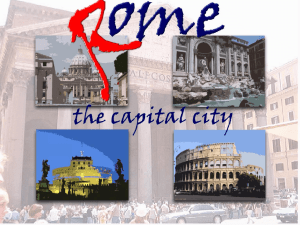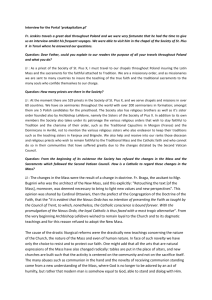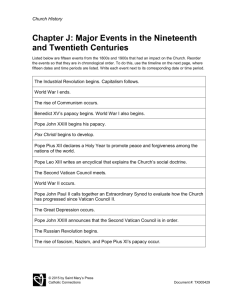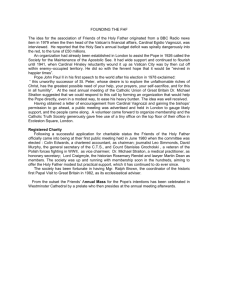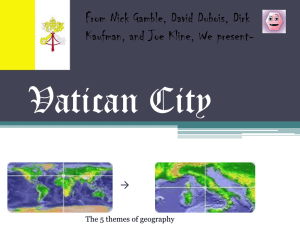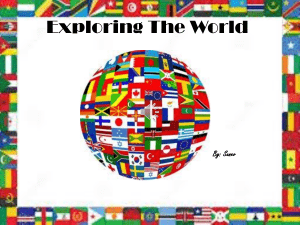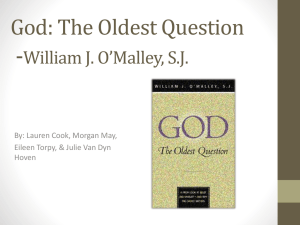Take TWO: Vatican II - Transfiguration Catholic Church
advertisement
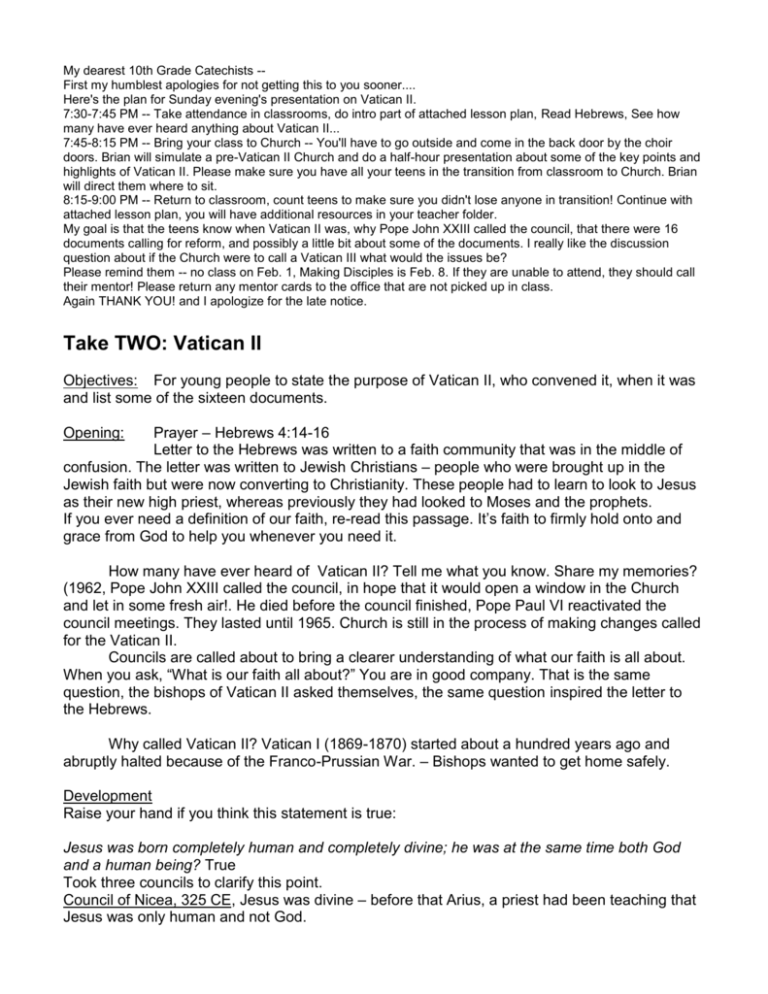
My dearest 10th Grade Catechists -First my humblest apologies for not getting this to you sooner.... Here's the plan for Sunday evening's presentation on Vatican II. 7:30-7:45 PM -- Take attendance in classrooms, do intro part of attached lesson plan, Read Hebrews, See how many have ever heard anything about Vatican II... 7:45-8:15 PM -- Bring your class to Church -- You'll have to go outside and come in the back door by the choir doors. Brian will simulate a pre-Vatican II Church and do a half-hour presentation about some of the key points and highlights of Vatican II. Please make sure you have all your teens in the transition from classroom to Church. Brian will direct them where to sit. 8:15-9:00 PM -- Return to classroom, count teens to make sure you didn't lose anyone in transition! Continue with attached lesson plan, you will have additional resources in your teacher folder. My goal is that the teens know when Vatican II was, why Pope John XXIII called the council, that there were 16 documents calling for reform, and possibly a little bit about some of the documents. I really like the discussion question about if the Church were to call a Vatican III what would the issues be? Please remind them -- no class on Feb. 1, Making Disciples is Feb. 8. If they are unable to attend, they should call their mentor! Please return any mentor cards to the office that are not picked up in class. Again THANK YOU! and I apologize for the late notice. Take TWO: Vatican II Objectives: For young people to state the purpose of Vatican II, who convened it, when it was and list some of the sixteen documents. Prayer – Hebrews 4:14-16 Letter to the Hebrews was written to a faith community that was in the middle of confusion. The letter was written to Jewish Christians – people who were brought up in the Jewish faith but were now converting to Christianity. These people had to learn to look to Jesus as their new high priest, whereas previously they had looked to Moses and the prophets. If you ever need a definition of our faith, re-read this passage. It’s faith to firmly hold onto and grace from God to help you whenever you need it. Opening: How many have ever heard of Vatican II? Tell me what you know. Share my memories? (1962, Pope John XXIII called the council, in hope that it would open a window in the Church and let in some fresh air!. He died before the council finished, Pope Paul VI reactivated the council meetings. They lasted until 1965. Church is still in the process of making changes called for the Vatican II. Councils are called about to bring a clearer understanding of what our faith is all about. When you ask, “What is our faith all about?” You are in good company. That is the same question, the bishops of Vatican II asked themselves, the same question inspired the letter to the Hebrews. Why called Vatican II? Vatican I (1869-1870) started about a hundred years ago and abruptly halted because of the Franco-Prussian War. – Bishops wanted to get home safely. Development Raise your hand if you think this statement is true: Jesus was born completely human and completely divine; he was at the same time both God and a human being? True Took three councils to clarify this point. Council of Nicea, 325 CE, Jesus was divine – before that Arius, a priest had been teaching that Jesus was only human and not God. Council of Ephesus, 431 CE, stated that Jesus was united as both God and man. A priest named Eutyches had been teaching that Jesus was not actually a human being but God merely appearing to be a human being. Council of Chalcedon, 451 CE, proclaimed that the Incarnation of Jesus meant that Jesus was equally and completely both human and divine. God the Father has the most power and is most important, Jesus the Son is in the second place, and the Holy Spirit is in third place. False We believe in one God who exists as three equal persons, as three equal expressions or modalities. Similar to H2O, which becomes 3 forms: ice, water and water vapor – each has the same chemical make-up. Council of Constantinople, 381 CE, proclaimed the equality of the Trinity – three persons all equal in one god – Father, Son and Holy Spirit. The Bible is the most important part of our faith; everything else is secondary and follows from the Bible. False We believe that the Scriptures (the Bible) and tradition (the way the Christian faith community has interpreted the revelation of God from the beginning) are equally important. The Christian Testament, is actually a written record of the very first traditions of Jesus’ early followers. These early traditions, continue as a guide for the ongoing development of tradition. Council of Trent 1545-1563, reaffirmed the Catholic belief that tradition is as important as the Bible. Martin Luther had sparked a movement that led to a Protestant position that the Bible was the only authority the church was to follow. Anything not mentioned in the Bible was to be eliminated from church practice and belief. Vatican Council II 1962-65, stated that the message of the Scriptures has been interpreted since its existence and is still being interpreted. What we call tradition is the same message of the Scriptures with all of its continuing interpretations. The pope is not capable of making a mistake due to his infallibility. False The pope is only infallible on matters of faith and morality or when speaking on behalf of the whole Church. Only used twice! Vatican I 1869-1870 – approved the doctrine of papal infallibility – although not all the bishops were in agreement. Councils are called to offer opportunities to discuss, clarify and publicly state in clear terms what makes us a church, what makes us followers of Jesus, what we believe and what these beliefs look like in real life. Exploring & Response Sixteen Documents of Vatican II and why they are important. Divide into 8 groups. Have each group pick 2 numbers between 1-16. Numbers indicate the statement numbers of the Vatican II documents that their group will be discussing. Give each group 2 slips of paper with quotations from the documents and 2 worksheets. Worksheet directions: 1. Rewrite the statement from the Vatican II as if its opposites were true. 2. List consequences that would result if this opposite statement were actually the one held by the Church. Explain why such a situation would not be good. 3. Describe how the real statement affects your faith and your life. 2 4. Share results with whole group. Conclude with these questions: Why is it a good idea for the church to make all of these public statements? Why is it important for the church to occasionally do its own self-renewal or examination? What is our personal faith all about? What does our personal faith have to do with Vatican II? If additional time: If the pope and his curia called a council today and asked you what three issues you would like the church to address, what issues would they be and what three decrees would you like the council to approve. Come to consensus as a group. Summarize What was the purpose of Vatican II, who convened it, when it was and list some of the sixteen documents. 3 Why is it a good idea for the church to make all of these public statements? Why is it important for the church to occasionally do its own self-renewal or examination? What is our personal faith all about? What does our personal faith have to do with Vatican II? If the pope and his curia called a council today and asked you what three issues you would like the church to address, what issues would they be and what three decrees would you like the council to approve. Come to consensus as a group. 4
